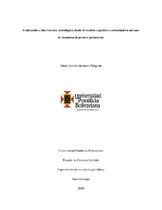Evaluación e intervención psicológica desde el modelo cognitivo conductual en un caso de trastorno depresivo intermitente

View/
Date
2020-03xmlui.dri2xhtml.METS-1.0.item-advisor
Ávila Lázaro, Jairo
xmlui.dri2xhtml.METS-1.0.item-type
Especialización
Citación
Metadata
Show full item recordDocuments PDF
Abstract
El siguiente trabajo monográfico presenta el proceso terapéutico realizado a una mujer de 45 años, quien acude al Centro de Proyección Social de la Universidad Pontifica Bolivariana para recibir orientación sobre cómo manejar la situación de autolesiones en su hija menor debido a que está generando perturbación emocional en la consultante. El proceso terapéutico tuvo una duración de aproximadamente cuatro meses y se realizaron 14 sesiones en total, las cuales estuvieron orientadas desde el enfoque cognitivo-conductual, iniciando por la fase de evaluación y diagnóstico siendo necesario el uso de entrevistas, pruebas psicométricas estandarizadas y la elaboración del análisis funcional. El proceso evaluativo permitió identificar que la usuaria cumplía con los criterios del Trastorno Depresivo Persistente (Distimia). teniendo en cuenta el trastorno, se diseñó un plan de tratamiento que permitiera a la consultante modificar creencias irracionales y disminuir su sintomatología depresiva a través de técnicas como: descubrimiento guiado, auto instrucciones, respiración profunda, imaginación, relajación progresiva y solución de .problemas, las cuales lograron según el análisis realizado de las pruebas pre y post, la reducción de la frecuencia e intensidad de la sintomatología ocasionada por los eventos estresantes, implementando patrones de respuestas más asertivas y eficaces en la solución de problemas. Se concluye que el tratamiento realizado impactó positivamente en la consultante y generó avance hacia su mejoría. This monographic work presents the therapeutic process performed to a 45-year-old woman, who attended to Centro de Proyeccion Social of the Universidad Pontificia Bolivariana to receive guidance on how to handle the self-harm pattern present in her youngest daughter as it is generating emotional disturbance to her. This therapeutic process lasted approximately four months and contained 14 sessions, which were oriented from the cognitive-behavioral approach, starting with the evaluation and diagnosis phase, in where the use of interviews, standardized psychometric tests and the preparation of Functional analysis were placed. This led to identified that the patient met the criteria of Persistent Depressive Disorder (Dysthymia). Therefore, a treatment plan was designed that allows the patient to modify irrational beliefs and reduce their depressive symptomatology through techniques such as: guided discovery, self-instructions, deep breathing, imagination, progressive relaxation and problem solving, this was achieved, according to the analysis of the before and after tests, as the reduction of the frequency and intensity of the symptomatology caused by stressful events and the implementation of more assertive and reduced response patterns in the solution of problems is present. It is concluded that the treatment carried out positively impacted the patient and generated progress towards her improvement.
Keyword/s
Modelo cognitivo
Modelo conductual
Intervención psicológica
Trastornos mentales
Depresión mental
Collections
- Trabajos de grado [6698]
The following license files are associated with this item:

